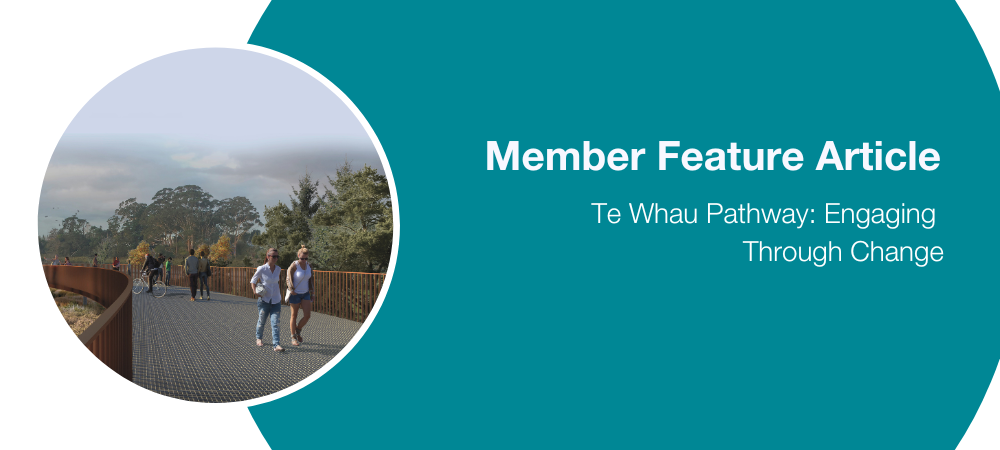Te Whau Pathway: Engaging Through Change

With Sarah MacCormick.
Even through the unprecedented disruption of the past few years, the principles of good engagement have stayed the same. Ultimately, it’s about taking your community on a journey by understanding them and their unique context. In the Te Whau project, Auckland Council and Beca had the opportunity to put these principles into action while evolving our methods to fit a COVID context.
Te Whau Pathway project is a shared cycling and walking pathway in West Auckland. It is being delivered in partnership through local authorities, iwi, and a community trust. The Pathway will provide an accessible, safe, and more convenient 12km route for pedestrians and cyclists to access greenspaces and community facilities.
Community and stakeholder engagement on Te Whau Pathway was delivered late2021 and early-2022 in an environment characterised by wide-spread disruption. Many reading this will remember Auckland moving in and out of COVID-19 lockdowns, which meant the Project team’s wellplanned face-to-face engagement was no longer appropriate.
Despite the disruption, the Project continued. We took deliberate steps to make sure as many people could have their say on this transformative project even if we couldn’t talk with them face-toface. We focused on three key principles: understanding the community; involving community members in early planning; and using new engagement methods.
Doing the work to understand the community.
Our first step was to understand the community to ensure that engagement would reach the right people, and that messaging would be well-understood. We gathered Statistics New Zealand Census data for communities along the route, to understand their demographic make-up.
Among other insights, this data highlighted there are many people who identify as Chinese along the pathway route.
Involving community members in engagement planning.
A Community Liaison Group made up of representatives from the community was set up early in the Project. The group met regularly with the design team and received project updates. They acted as champions for the project in the community and were a valuable sounding board. The group was instrumental in testing the wider public consultation process before implementation.
We took the Statistics New Zealand Census data to the Group early in the planning process, which helped test and expand our methods. We identified an opportunity to advertise and engage on WeChat (the most popular Chinese-language messaging app, with over a billion monthly users). Because of our collaboration with the Group, we received useful and high-quality feedback through a social media platform the team did not originally have access to, and a significant number of responses from the Chinese community.
Using new engagement methods.
Before the 2021 COVID-19 lockdowns we had planned for public drop-in sessions, websites, surveys, and feedback forms. The lockdowns that affected the project were announced with very little lead time and meant we needed to engage 100% online. We added some new engagement methods to our plan including Artificial Intelligence alongside the more traditional methods which included an online and hard copy feedback form.
FranklyAI (Frankly) is an interactive conversational agent which ‘chatted’ with respondents while they answered the consultation questions. A Social Pinpoint site was also set up for the project, which enabled people to view the entire project alignment on an interactive map and then click through to more detailed plans of each section. The Social Pinpoint site also allows users to ‘post’ feedback about a given location by clicking on that location.
We linked the two tools for a unique user experience. Clicking on an icon on Social Pinpoint would prompt Frankly to ask for feedback on certain elements of the design. Users could jump between the two tools, for example giving quick feedback by dropping pins on the map, and then providing more detailed feedback on a particular element by chatting to Frankly.
There were tangible benefits to the project by using Social Pinpoint and Frankly in this way:
- Many young people were attracted to have their say. The 16–30 year-old cohort was the largest among Social Pinpoint users, whereas the largest age bracket for the traditional online feedback form was 35-55. Those aged 55 and older made up just under a third of respondents.
- A Mandarin translation added to the chatbot (coupled with our engagement over WeChat) meant one third of respondents on Social Pinpoint identified as Chinese compared to one third of respondents of the traditional online survey who identified as European which reflected more of the demographic make-up of the community.
Overall, we were delighted with the results of the engagement. While such extensive lockdowns are (hopefully) a thing of the past, this engagement process has taught us the value of understanding the community and having a range of methods and tools at your disposal.

